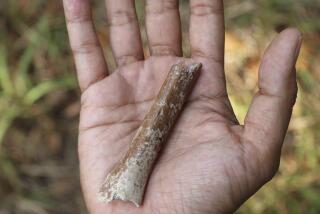Find Suggests Earlier Date for Human Beings
- Share via
Scientists have determined that a human skull part found in Kenya is 2.4 million years old--a discovery that pushes back the known antiquity of the genus Homo, and thus the emergence of the first true human beings, by 500,000 years.
The new date places the origin of human beings squarely within a period of major climate change--a global cooling already believed to have caused other mammalian groups to undergo dramatic bursts of evolutionary diversification. If true, then today’s human beings owe their existence to the same climate changes that shaped many other species as well.
In addition, the discovery provides a plausible candidate for the title of first maker of stone tools. The oldest known stone tools--crudely chipped stones found in Ethiopia--were made between 2.4 million and 2.6 million years ago. But until now the only known hominid, or human ancestor, living then was the more primitive Australopithecus, the ancestor of the first Homo.
Homo (Latin for “man” ) is the genus that includes modern people, Homo sapiens, as well as our ancestor, Homo erectus, and the still older ancestor of that species, Homo habilis. The skull fragment may have been Homo habilis.
The discovery, reported in today’s issue of the journal Nature by Andrew Hill of Yale University and Steven Ward of the Northeastern Ohio Universities College of Medicine, involves an isolated temporal bone, which is the part of the skull around the ear and includes the hinge of the lower jaw. It was found in 1965 by John Martyn, a geologist working in the Chemeron Beds, a fossil-rich formation in Kenya’s Great Rift Valley.
The 2.4-million-year date does not change the generally accepted story of human evolution. In that scenario, the common ancestor of apes and humans is presumed to have lived between 5 million and 10 million years ago. It gave rise to two new lineages, one that became the modern apes and one that became modern humans.
The earliest known member of the hominid lineage is Australopithecus afarensis, best known from the skeleton called Lucy. Various specimens range in age from just under 4 million years to about 2.5 million years. Though Australopithecus walked on two legs, its brain size was about that of a chimpanzee.
The period between 2.5 million and 1.5 million years ago is one of the most confusing in human evolution because there appear to have been at least three kinds of hominids living at the same time in Africa. There were at least two new forms of Australopithecus (called A. africanus and A. boisei ), as well as the first hominid with a significantly enlarged brain, called Homo habilis. Some experts say there were other species of Homo as well.
Hints of an early Homo emerged some years ago when F. Clark Howell of UC Berkeley found some isolated teeth in Ethiopia’s Omo River valley that he suggested were Homo. They were 2.4 million years old.






